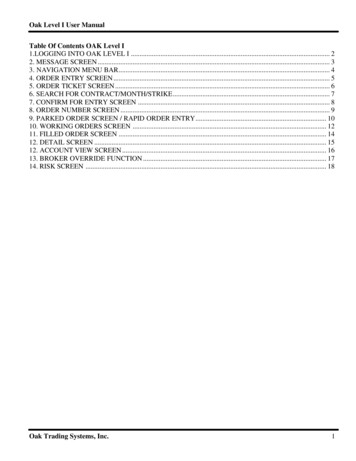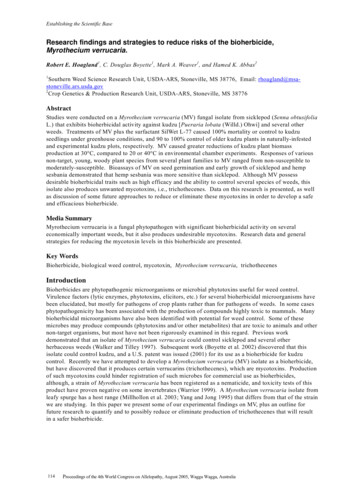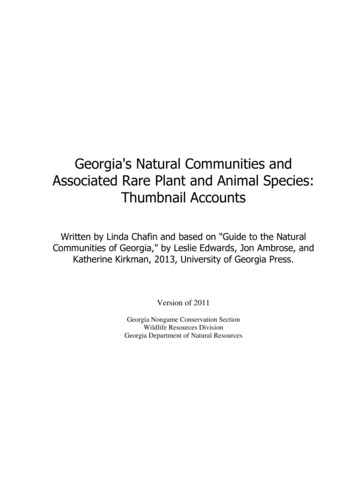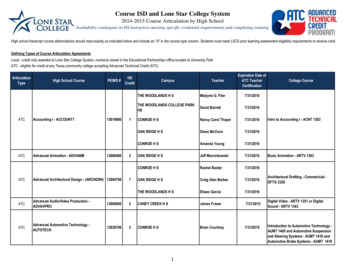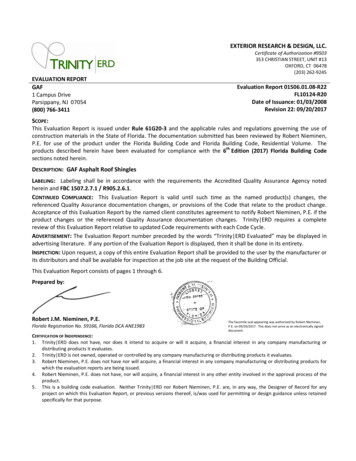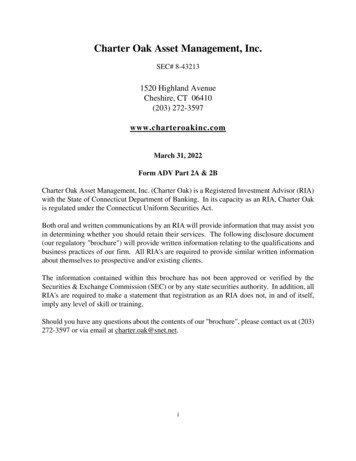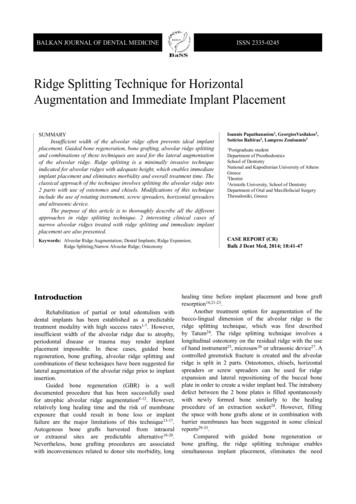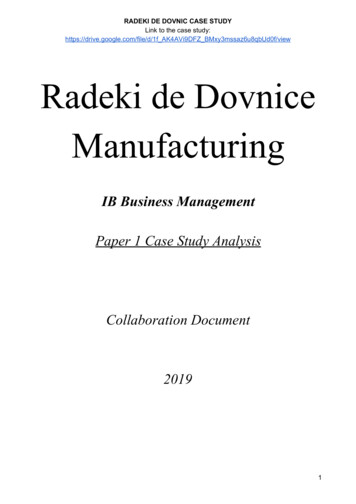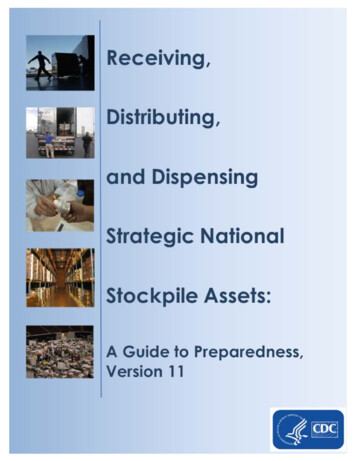
Transcription
Table of ContentsIntroduction to the Strategic National Stockpile. 1The Strategic National Stockpile Formulary . 2Chapter 1: Concept of Medical Countermeasure Operations . 3Chapter 2: Developing a Medical Countermeasure Response Plan. 4Chapter 3: Management of Medical Countermeasure Operations . 5Chapter 4: Requesting SNS Assets . 6Chapter 5: Receiving, Staging, and Storing Medical Countermeasures . 7Chapter 6: Managing Medical Countermeasure Inventory . 8Chapter 7: Distributing Medical Countermeasures . 9Chapter 8: Dispensing Medical Countermeasures . 10Chapter 9: Public Information and Communication . 11Chapter 10: Strategic and Tactical Communications . 12Chapter 11: Securing Assets, Staff, and Operations . 13Chapter 12: Hospital and Treatment Center Coordination . 14Chapter 13: Training, Exercising, and Evaluating Plans . 15Appendix A: Federal Medical Stations . 16Appendix B: Ventilators . 17Appendix C: CHEMPACK . 18Appendix D: DTPA . 19Appendix E: Cold Chain Management . 20Acronyms and Abbreviations . 21
Introduction to the StrategicNational StockpileThe Centers for Disease Control and Prevention (CDC)’s Strategic National Stockpile (SNS) is arepository of potentially life-saving pharmaceuticals and medical supplies for use in a publichealth emergency in which local supplies have been or may be depleted. The SNS programhas grown over the years to encompass a wide range of medical countermeasures (MCMs)and response capabilities. Receiving, Distributing, and Dispensing Strategic NationalStockpile Assets: A Guide for Preparedness, Version 11, is intended to help public health andemergency management personnel at the state, local, tribal, and territorial (SLTT) levels ofgovernment prepare to request and make effective use of MCMs to prevent, mitigate, ortreat adverse health effects from an intentional, accidental, or naturally occurring publichealth emergency.Building the Strategic National Stockpile ProgramThe SNS program was established with nominal funds in 1999 as part of the nation’spreparedness against potential incidents involving select Category A agents (e.g., botulism,anthrax, smallpox, plague, and tularemia).Following the deployment of SNS assets to NewMedical CountermeasuresYork City to mitigate effects of the September11, 2001, terrorist attacks on the World TradeAccording to the Public Health EmergencyMedical Countermeasures EnterpriseCenter and in response to the anthrax attacks(PHEMCE), medical countermeasuresin October of that year, the program grew(MCMs) include both pharmaceuticalexponentially. Those incidents promptedinterventions (e.g., vaccines,federal legislation and directives that rapidlyantimicrobials, antidotes, and antitoxins)facilitated and strengthened public healthand non-pharmaceutical interventionsemergency preparedness efforts and the SNS(e.g., ventilators a personal protectiveprogram. Such legislation and directivesequipment [PPE]) that may be used toincluded the Pandemic and All-hazardsprevent, mitigate, or treat adverse healthPreparedness Act (PAHPA) 1 of 2006, whicheffects from an intentional, accidental, orintroduced benchmarks for public healthnaturally occurring public healthemergency.preparedness, and Homeland Security2Presidential Directive 21 (HSPD-21), whichspecifically addressed preparedness ault.aspx2www.fas.org/irp/offdocs/nspd/hspd-21.htm
catastrophic health events and stressed the importance of ensuring communities can“distribute and dispense countermeasures to their populations within 48 hours after a decisionto do so.” 3In addition, the National Health Security Strategy (NHSS) 4 refocused the various existingstrategies for “public health and medical preparedness, response, and recovery to ensurethat the nation is prepared for, protected from, and resilient in the face of health threats orincidents with potentially negative health consequences” 5 and includes an effectivecountermeasure enterprise as one of the 10 strategies designed to support its goals. Thisstrategy has guided the creation, development, manufacture, staging, maintenance, andprioritization of MCMs, as well as their timely distribution, delivery, and dispensing. In addition,this strategy requires SLTT officials to set priorities for how their jurisdictions will allocate MCMswhen the supplies are limited.Presidential Policy Directive 8 (PPD-8) was signed in March 2011 and serves to strengthen thenation’s security and resilience through systematic preparation for the threats that pose thegreatest risk, such as acts of terrorism, pandemics, and catastrophic natural disasters. ThePPD-8 implementation plan includes the National Preparedness Goal, 6 which sets the overallstrategic vision for national preparedness and establishes core capabilities used to drivepreparedness activities nationwide. The National Preparedness Goal reflects the policydirection outlined in the National Security Strategy (May 2010), 7 applicable PPDs, HSPDs,National Security Presidential Directives, and national strategies.This legislation serves to strengthen the SNS program, which not only stockpiles the nation’scache of pharmaceuticals and medical supplies but also develops rapid responsecapabilities to support the delivery of SNS assets to locations in which they may be needed.Since the program’s inception, CDC has deployed federal assets in response to large-scaleincidents, such as the 2009 – 2010 H1N1 influenza pandemic, and to smaller incidents thataffect a single person, such as the delivery of vaccinia immune globulin (VIG) to treatadverse reactions related to smallpox vaccination.Connecting CDC’s Oversight and Support StructuresCDC’s Office of Public Health Preparedness and Response (OPHPR) has primary oversightand responsibility for all programs that comprise CDC's public health preparedness andresponse portfolio. Through an all-hazards approach to preparedness – focusing on threatsfrom natural, biological, chemical, nuclear, and radiological incidents – OPHPR helps gy/Documents/nhss-final.pdf5Health and Human Services (HHS), Office of the Assistant Secretary for Preparedness and Response (ASPR).National Health Security Strategy [online]. Available at g.pdf7www.whitehouse.gov/sites/default/files/rss viewer/national security strategy.pdf
nation prepare for and respond to urgent threats to the public's health. OPHPR carries out itsmission by emphasizing accountability through performance, progress through public healthscience, and collaboration through partnerships.Within OPHPR, two main divisions provide oversight and support to state and localjurisdictions related to an MCM response: Division of Strategic National Stockpile and Divisionof State and Local Readiness.Division of Strategic National StockpileThe Division of Strategic National Stockpile (DSNS) includes specialists in emergencyresponse, logistics, science, and public health preparedness who manage the SNS formulary,staff the DSNS operations center, and provide training and exercise support to SLTT publichealth departments. The DSNS mission is to prepare and support partners and provide theright resources at the right time to securethe nation’s health.DSNS MissionDSNS’ organizational structure includesthree branches under the Office of theDirector: Logistics Branch, ProgramPlanning and Analysis Branch (PPA), andResponse Branch.Prepare and support partners and providethe right resources at the right time tosecure the nation’s healthThe Office of the Director is comprised of the Science Team, the Healthcare PreparednessActivity (HPA), and the Community Resilience Activity (CRA). The Science Team manages themedical, pharmaceutical, and scientific oversight of the SNS formulary and ensures thescientific review of all medical assets. HPA works to improve the healthcare delivery system’sability to respond to potential natural disasters and public health threats and provides toolsand other resources intended to enhance preparedness from multiple sectors that affecthealthcare and public health. CRA serves as a point of contact for federal agencies, nongovernmental organizations, and partners for initiatives and issues relating to the contents,management, deployment, and use of SNS assets. CRA also develops and implementsinnovative strategies and solutions to reduce the burden of MCM distribution and dispensingon state and local public health agencies.PPA supervises the design, implementation, and day-to-day execution of processes andsystems to improve cost analysis, cost evaluation, planning, and financial management forDSNS.The Logistics Branch is responsible for the procurement, management, and maintenance ofSNS assets, including quality control. This branch also manages the CHEMPACK and FederalMedical Station (FMS) programs, which are described in The Strategic National StockpileFormulary section of this guide.The Response Branch is responsible for planning related to the management of SNS activitiesduring a public health emergency and provides information to SNS leadership that informsstrategic decision-making. The Response Branch includes the Current Operations Team, theDeployment Coordination Team, the Training Team, and the Exercise Team. The Current
Operations Team is responsible for the day-to-day operational activities of DSNS. Theseactivities include monitoring news, weather, and information outlets for incidents, maintainingthe DSNS Team Room in the CDC Emergency Operations Center and alternate emergencyoperations sites, and managing asset deployment missions. The Deployment CoordinationTeam supports, trains, and equips the teams of deployable personnel designated to provideSNS-specific assistance to state and local officials during a public health emergency. TheTraining Team develops and implements training for SNS personnel and SLTT partners. Inaddition, the Exercise Team provides support for national, state, and local SNS exercises.Division of State and Local ReadinessThe Division of State and Local Readiness (DSLR) administers CDC’s Public Health EmergencyPreparedness (PHEP) cooperative agreement. 8 PHEP supports preparedness activities andprovides technical assistance to 62 state, local, and territorial PHEP awardees, including the50 states, four major metropolitan areas (Chicago, Los Angeles County, New York City, andWashington, D.C.), and eight U.S. territories and freely associated states (American Samoa,Guam, U.S. Virgin Islands, NorthernMariana Islands, Puerto Rico, FederatedDSLR MissionStates of Micronesia, Republic of theMarshall Islands, and Republic of Palau).Assure the nation’s public health system isThe mission of DSLR is to assure the nation’sprepared and capable to respond to andpublic health system is prepared andrecover from public health emergenciescapable to respond to and recover frompublic health emergencies.DSLR’s organizational structure includesthree branches: Applied Science andEvaluation Branch, Field Services Branch,and Program Services Branch.The mission of the Applied Science andEvaluation Branch (ASEB) is to strengthenpublic health preparedness, response,and recovery through science andevaluation. ASEB focuses on theeffectiveness of the PHEP cooperativeagreement, interdisciplinary preparednessscience, collaboration with health securitypartners, and evidence-basedrecommendations to improve the qualityof decision-making on preparedness andresponse activities.DSNS PPB Moves to DSLRIn April 2012, DSNS’ Program Preparedness Branch(PPB) was realigned with the Division of State andLocal Readiness (DSLR)’s Program Services Branch(PSB). CDC implemented this transition to betteralign and support the technical assistance itprovides to state and local public health partners.PSB continues to provide technical assistance formedical countermeasure distribution anddispensing (MCMDD) planning and assist the 62jurisdictions that are funded through the PHEPcooperative agreement. The PPB data team isnow aligned within DSLR’s Applied Science andEvaluation Branch (ASEB), where it continuescollecting and monitoring data associated withMCMDD planning and operations.The Field Services Branch (FSB) supportsstate, local, and territorial health departments with field-based staff, including .htm
field associates (PFAs) and members of CDC’s Career Epidemiology Field Officer (CEFO)Program. FSB staff work directly in jurisdictions to enhance state, local, and territorial publichealth preparedness and assist in developing DSLR’s science agenda and strategies.The Program Services Branch (PSB) provides programmatic oversight and coordinatestechnical assistance (TA) for PHEP awardees. PSB project officers work with state, local, andterritorial health agencies to clarify PHEP program requirements and provide guidanceregarding program implementation activities designed to build and sustain the 15 publichealth preparedness capabilities, including MCM distribution and dispensing (MCMDD)planning.Each jurisdiction receives MCMDD technical assistance from public health advisors who aresubject matter experts on SNS/MCMDD operations, the emergency response infrastructure,and PHEP cooperative agreement requirements. Project officers provide guidance on howto improve preparedness and plan coordinated and efficient responses. These projectofficers serve as the jurisdictions’ conduit for many different types of TA, including Access to program guidance documents, planning tools, and templates; Review and assessment of MCMDD plans; Support for exercises and evaluations; Access to SNS-specific online resources including the SNS Extranet9 and SNSSharePoint 10 sites; Training; Direct consultation and guidance with planning staff; and Support for conducting distribution and dispensing modeling to test and refine plans.Public Health Emergency Preparedness (PHEP) Cooperative AgreementThe PHEP cooperative agreement is a critical source of funding to assist state and localpublic health departments in building and strengthening their abilities to respond effectivelyto the public health consequences of infectious disease outbreaks, natural disasters, andbiological, chemical, nuclear, and radiological emergencies, as well as terrorist threats. ThePHEP cooperative agreement also provides dedicated funding for the Cities ReadinessInitiative (CRI), 11 which supports MCMDD planning for all hazards in 72 metropolitan areas.CRI is intended to help jurisdictions develop the capabilities needed for “U.S. cities to respondto a large-scale biologic attack, with anthrax as the primary threat consideration” (ExecutiveOrder 13527). 129www.orau.gov/snsnet/default.htm. The SNS Extranet is password protected. Login information is available fromthe state SNS coordinator or DSLR project officer.10www.orau.gov/snsnet/sharepoint-site.htm, registration is required for the SNS SharePoint site and instructions forregistration are available on the front /irp/offdocs/eo/eo-13527.htm
In March 2011, CDC released Public Health Preparedness Capabilities: National Standards forState and Local Planning 13 to assist awardees in their public health preparedness planning.This guide established national standards for state and local public health preparednesscapabilities-based planning and assists state and local public health planners in identifyinggaps in preparedness, determining specific jurisdictional priorities, and developing plans forbuilding and sustaining public health capabilities. Two of the 15 public health preparednesscapabilities include standards for MCMDD. The PHEP cooperative agreement providesfunding, technical assistance, and other resources that support state, local, and territorialpublic health departments in demonstrating measurable and sustainable progress towardachieving the 15 public health preparedness capabilities.Medical Countermeasure Operational Readiness ReviewsDSLR project officers assess jurisdictional MCMDD planning and preparedness through annualreviews that aid jurisdictions in identifying gaps in their plans to receive and manage MCMs.Project officers work collaboratively with jurisdictions to schedule and conduct these reviewsand assess each jurisdiction’s planning efforts. For over ten years, CDC conducted SNStechnical assistance reviews (TARs) to assess state, local, and territorial MCM plans andprovide a score between 0 and 100 using the state, local, or island TAR tool. Effective July2014, CDC is updating the medical countermeasure assessment to facilitate review of MCMplans for operational capability. CDC designed the updated operational readinessassessment to improve and advance state, local, and territorial MCM planning and responseand to align MCM planning with the 15 public health preparedness capabilities.Using This Preparedness GuidePrevious versions of this guide focused significantly on the scenario of a release of aerosolizedanthrax, which would require jurisdictions to prepare for dispensing MCMs within 48 hours.However, Version 11 takes into account a growing range of threats, changes to the amountand variety of stockpiled assets, and the existence of more comprehensive planning andpreparedness processes in many jurisdictions. Considering the wide variety of potential publichealth threats and MCMs available to mitigate those threats, planning for this type ofemergency response should be scalable and flexible.Maintaining a state of readiness through constant planning is a central theme of this guide,but planning alone is not enough. The purpose of MCMDD preparedness planning is to buildthe capability to respond effectively, save lives, and prevent disease. Once the jurisdictiondevelops an MCMDD plan, it should implement the plan with people and resourcesidentified to support it. Jurisdictions should maintain preparedness through regular Planning and review of existing plans; Training of the primary and back-up personnel who will staff the plan functions; Exercising the functions in the plan; Evaluating staff readiness and whether plans are operational; Assessing the adequacy of facilities vital to the jurisdiction’s infrastructure; and13www.cdc.gov/phpr/capabilities
Reviewing and updating written agreements that will ensure use of any facilities orequipment.To foster an all-hazards approach to planning, the chapters of this guidance do not mirrorprevious versions. Chapter 1 of this guide outlines the concept of operations for a large-scaleresponse in which jurisdictions may request federal assets, while Chapters 2 through 13represent the 12 functional areas of MCMDD planning. CDC removed the repackagingfunction as DSNS established contingencycontracts with firms that can repackage12 Functional Areas of MCMDD Planningtens of thousands of regimens per day andhave agreed to use their production lines to Developing a Medical Countermeasurerepackage SNS assets during a large-scaleResponse Planpublic health emergency. The components Management of Medical Countermeasureof the SNS formulary mentioned in thisOperationsoverview are described in greater detail in Requesting Strategic National Stockpilethe following chapters and appendices.AssetsRealizing that most planners will not read this Receiving, Staging, and Storing Medicalguide in a single sitting, each chapter isCountermeasuresdesigned to stand alone – with individual Managing Medical Countermeasurepage numbers and acronyms defined – toInventoryfacilitate use by and sharing among variouspublic health and emergency response Distributing Medical Countermeasurespartners. Planners may choose to print this Dispensing Medical Countermeasuresguide, along with its table of contents andtitle page, and keep in a notebook with Public Information and Communicationseparate tabs for each chapter, or planners Strategic and Tactical Communicationscan use the electronic version, which hasbookmarks for each chapter. The Securing Assets, Personnel, anddevelopers of this documentOperations(representatives from DSNS and DSLR) Hospital and Treatment Centersincerely hope that this updated guidanceCoordinationprovides a comprehensive picture of the Training, Exercising, and Evaluating PlansMCMDD planning process and assists SLTTpartners in developing scalable and flexibleMCMDD plans.
The Strategic NationalStockpile FormularyThe items included in the Strategic National Stockpile (SNS) are referred to as its formulary.Various federal workgroups and agencies collaborate to determine which items to include inthe formulary based on specific threats to the United States as well as other factors. The SNSformulary has grown to encompass a wide range of medical countermeasures (MCMs),including both pharmaceutical interventions (e.g., vaccines, antimicrobials, antidotes, andantitoxins) and non-pharmaceutical interventions (e.g., ventilators and personal protectiveequipment [PPE]). These MCMs can be used to prevent, mitigate, or treat adverse healtheffects from any type of public health emergency, whether man-made or naturallyoccurring. The SNS formulary is configured in various response capabilities to facilitate rapidmovement around the nation. Understanding how the SNS formulary is selected, what assetsare available, and how the Centers for Disease Control and Prevention (CDC) will deploythose assets can aid jurisdictions in developing plans for requesting, receiving, distributing,and dispensing MCMs.Understanding SNS Formulary DevelopmentThe Public Health Emergency Medical Countermeasures Enterprise (PHEMCE) 1 determineswhich products to include in the SNS formulary. PHEMCE is a federal interagency workinggroup consisting of members from the Department of Health and Human Services (HHS),including members from CDC, the National Institutes of Health (NIH), and the U.S. Food andDrug Administration (FDA); the U.S. Department of Homeland Security (DHS); the VeteransAdministration (VA); and the Department of Defense (DoD). PHEMCE subject matter expertsreview threat assessments, collaborate to determine specific MCMs required to respond tothose threats, and recommend specific MCMs for inclusion in the SNS formulary.While many countermeasures included in the SNS formulary are readily available, theBiomedical Advanced Research and Development Authority (BARDA) 2 assists in obtainingproducts that are not available in the marketplace by facilitating the development of newMCMs to treat specific disease conditions. BARDA was established through the Pandemicand All-hazards Preparedness Act (PAHPA) 3 of 2006 as the focal point within HHS for lt.aspx
advanced development and acquisition of MCMs. BARDA manages Project BioShield, 4which includes the procurement and advanced development of MCMs for chemical,biological, radiological, and nuclear (CBRN) agents. Project BioShield also includes theadvanced development and procurement of MCMs for disease outbreaks outside of itsCBRN scope, such as influenza pandemics and other emerging infectious diseases. Inaddition, BARDA manages PHEMCE.While PHEMCE identifies the most effective MCMs, other factors are considered whenselecting items for the SNS formulary. Consequently, each item included in the SNS formularyis selected based on specific criteria, which can be defined by the mnemonic REASON (SeeFigure F-1).Figure F-1: REASON mnemonicEach item considered for inclusion in the SNS formulary is reviewed under REASON todetermine its rotation capability for going back into the commercial market; its effectivenessagainst specific disease agents; its supply availability in the commercial market; its storageconsiderations; other considerations, such as the costs for obtaining and maintaining theproduct, the multiplicity of the product use against various disease agents, and theregulatory requirements; and what ancillary supplies (e.g., intravenous sets, needles, etc.)are needed to support product use.In general, the SNS contents are categorized based on specific threats, including Category Aagents, radiological and nuclear, chemical, bacterial, and influenza (see Table F.1).While it is important to note that Table F.1 depicts the broader category of assets in the SNS,a variety of planning considerations can impact a jurisdiction’s ability to receive, distribute,and dispense certain items to the affected populations quickly and efficiently. For example,certain vaccines deployed from the SNS require special cold chain management ect-bioshield-overview.aspx
temperature monitoring throughout all levels of distribution to help ensure product stability.Additionally, some countermeasures, such as anthrax immune globulin, may be deliveredfrom the SNS directly to hospitals as opposed to receipt, stage, store (RSS) facilities.Table F.1: SNS Formulary by Specific Threat*ThreatKey SNS Products to Treat/Prevent Illness from ThreatAnthraxAntimicrobials (ciprofloxacin, doxycycline, amoxicillin, penicillin,clindamycin, rifampin, vancomycin, levofloxacin); anthrax immuneglobulin (AIG); raxibacumab; and anthrax vaccine adsorbed (AVA)PlagueAntimicrobials (ciprofloxacin, doxycycline, gentamicin, levofloxacin)TularemiaAntimicrobials (ciprofloxacin, doxycycline, gentamicin)SmallpoxVaccine (ACAM2000, Aventis Pasteur-WetVax, Modified VacciniaAnkara)Treatment of adverse reactions to vaccine: vaccinia immune globulin(VIG); cidofovir; tecovirimat for treatment of smallpox and treatmentof complications from smallpox vaccineBotulismAntitoxins (Heptavalent A and botulinum antitoxin)ChemicalCHEMPACK – atropine, pralidoxime, diazepam, Mark 1 kits/DuoDotesRadiationPrussian blue; calcium- (Ca) and zinc (Zn)-Diethylenetriaminepentaacetic acid (DTPA); granulocyte colony-stimulating factor, suchas Neupogen (filgrastim); antiemetics; limited IV antimicrobials forsecondary infectionsBurn/BlastMedical/surgical supplies; IV fluidsInfluenza (Pandemic)Antiviral drugs (oseltamivir and zanamivir); personal protectiveequipment (PPE) (gloves, N-95 respirators and surgical masks, gowns);limited IV antimicrobials for secondary infectionsNatural DisastersMedical/surgical supplies and equipment; IV fluids; Federal MedicalStations (FMS)* The SNS has medical supplies and equipment, including a limited number of ventilators, to support allthreats listed in Table F.1.Anthrax Vaccine Adsorbed (AVA), ABthrax, and Anthrax Immune Globulin (AIG)Anthrax vaccine adsorbed (AVA) can be used as pre- and post-exposure prophylaxis forpeople who potentially may be exposed to Bacillus anthracis and, in some cases, peoplewho are suspected of having been exposed to B. anthracis. Pre-exposure vaccine use islimited to military personnel and laboratorians working directly with the disease agent,though may be soon become available to emergency responders. Only pre-exposure
vaccination is FDA approved. SNS holds a limited supply of AVA. Jurisdictions should beaware that during an anthrax response, AVA can be administered to all adults (those over18) under an Emergency Use Authorization (EUA) 5 for post-exposure prophylaxis, but forpediatric patients, AVA will require an Investigational New Drug (IND) protocol. 6 Chapter 8:Dispensing Medical Countermeasures provides further information on INDs and EUAs.ABthrax (raxibacumab) is FDA approved for prophylaxis and for treatment of severe anthraxdisease following exposure to B. anthracis. Raxibacumab can be used for treatment ofinhalation anthrax in combination with appropriate antimicrobial drugs, as well as forprophylaxis of inhalation anthrax when alternative therapies are not available orappropriate. A limited supply of raxibacumab is available from the SNS on a patient-bypatient basis.Anthrax immune globulin (AIG) can be used for the treatment of severe anthrax diseasefollowing exposure to B. anthracis. A limited supply of AIG is available from the SNS under anEUA o
field associates (PFAs) and members of CDC's Career Epidemiolog y Field Officer (CEFO) Program. FSB staff work directly in jurisdictions to enhance state, local, and territorial public health preparedness and assist in developing DSLR 's science agenda and strategies.

